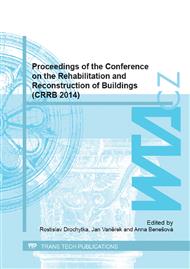p.243
p.249
p.253
p.257
p.261
p.265
p.269
p.273
p.278
The Corner Radius Influence on the Deformation Behavior of Brick Pillars Strengthened by CFRP Confinement
Abstract:
The article addresses the issues of the application of materials based on high-strength carbon fibers as external glued transverse confinement of concentrically compressed masonry pillars. Transverse confinement of compressed pillars contributes to their enhanced load-bearing capacity and ductility due to the introduction of horizontal forces and creation of multi-axial compressive loading of masonry.The article describes experimental research within the NAKI, DF12P01OVV037 research project. The research was carried out on a set of brick pillars with dimensions of 286 x 286 x 870 mm, reinforced by confinement in carbon fibers in an epoxy resin matrix. The corner edges of brick pillars were treated by rounding with radii of 20 mm, 35 mm, 50 mm and 85 mm. To conclude, the article compares differently treated pillars in terms of the ultimate load reached, the deformation behavior, stress states in the transverse reinforcement, the pillars’ failure mode and the crack pattern along the cross section. Based on the comparison, some findings are formulated.
Info:
Periodical:
Pages:
273-277
Citation:
Online since:
August 2015
Authors:
Keywords:
Price:
Сopyright:
© 2015 Trans Tech Publications Ltd. All Rights Reserved
Share:
Citation:


